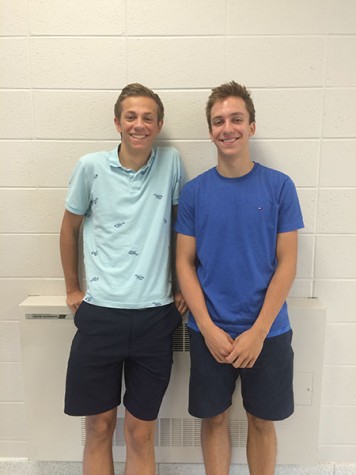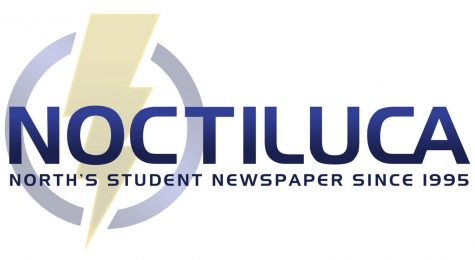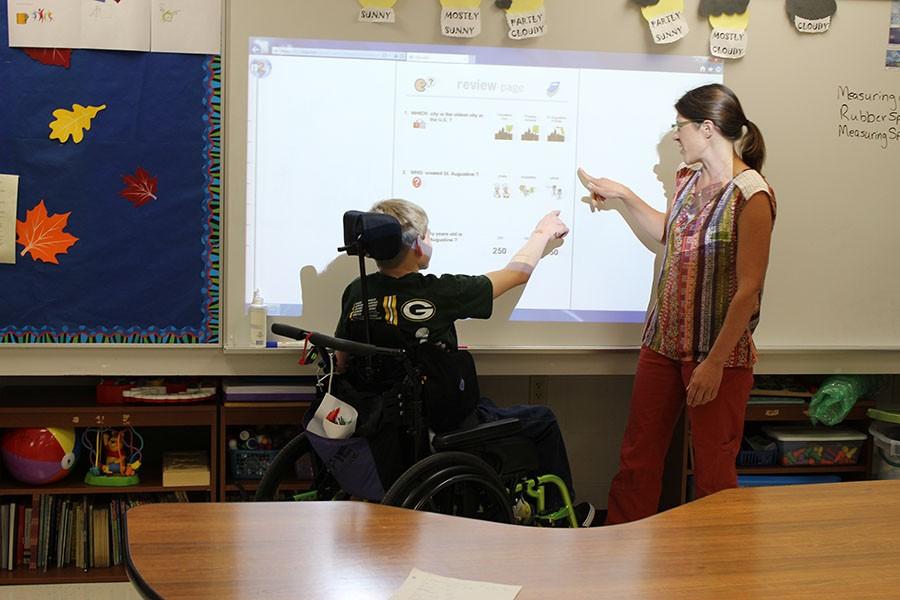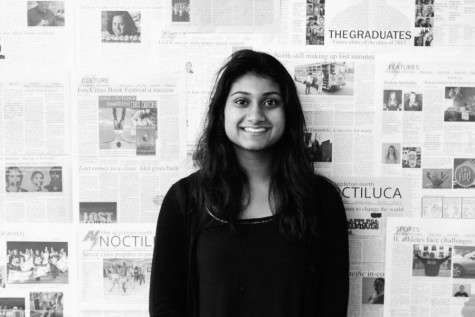Seniors raise awareness for people with differing abilities
Ms. Brown teaches student Foster Klein in one of the special education classrooms. SNAP aims to create more friendships and more inclusion for special needs students at North.
November 29, 2015
North seniors Matt Robbins and Scott Rakestraw are making a positive difference at Appleton North by starting the Special Needs Awareness Program, or SNAP for short. The club aims to create friendships and promote inclusion and awareness within the culture of special needs.
“Basically we are going to have different events and different aspects of our club which will encompass our two goals,” Robbins said.
Robbins explained his motivation in starting SNAP: “Last year I was a junior at Appleton North and my brother, Michael, was a freshman and it was really the first time we had been at a school together. I always understood that school was difficult for him due to social problems and anxiety and just not being able to do things people without special needs would do. It was different seeing him at school, and lunch was kind of the big part of starting this [SNAP] because I would be sitting with my friends and I would see him sitting alone and then I said ‘How can we change this?’ Maybe it’s not gonna happen right away, maybe it’s not gonna happen in a year, but how can we get closer to changing this?”

Seniors Scott Rakestraw (left) and Matt Robbins (right) are starting SNAP at North.
Rakestraw’s experience is similar. “Growing up I always knew the special needs kids were there, but I didn’t really understand why they were different or why we went to the same school but they never were really with us,” he said. “They do not have the same activities as us and they were not really around us. Going into high school I sort of saw the same thing, they were separate from us and I would say hi to Michael in the halls last year and try to talk to him and people always tried to shoo him away from us. They want personal connections too and they just don’t get that in their groups.”
The club will meet the first Thursdays of every month and throughout the year the club aims to have different events and campaigns that members can help out with, such as Spread the Word to End the Word, Lightning Buddies, helping out with Special Abilities Homecoming, the People First campaign, the Allies for Inclusion: The Ability Exhibit, and other events that will come up later in the year. “What we do will be dynamic; it’s different. We don’t do just one thing, not all of us are just volunteers. You can be part of SNAP and not be a Lightning Buddy but you may be helping out with the Abilities exhibit,” Robbins said.
Lightning Buddies will be an intervention program at lunch where every week for two days students can sit with the special needs students to make them feel more included in the social lunch atmosphere, which would be based on schedules.
Mrs. Bruce will be starting a Special Abilities homecoming, which SNAP would not run, but would help promote and help out with the dance. “Over the years there has always been the special abilities Prom which was great,” Rakestraw said, “but it was so close to the end of the year that people would make all these great friendships but then it would be time for them to leave or graduate, so we wanted to have a dance earlier in the year so everyone can interact earlier on and build these great friendships and continue them throughout the year.”
“The Ability Exhibit will really be the biggest event for SNAP though; it’s the starting kickoff event,” Rakestraw said. The exhibit will last three days from Nov. 30-Dec. 4 and is put on by graduate students from St. Louis University. There will be 10 interactive exhibits that teach about disabilities and about how to properly interact with people with these differing abilities. It is the first time this exhibit will be showcased by a high school in the nation, as it is usually done by corporations and larger organizations. It will be open during the school day, but in the evenings it will be open to the public to get a wide range of people to come through.
“The disabilities that will be displayed are not even just like autism [or] down syndrome, they will include things like deafness [and] anxiety, really things people do not think of when they think of disabilities and it really explores that within our culture,” Robbins said. “We are going to personally send invitations to different businesses and support groups so we can really open it up to the public. This year is also the 25th anniversary of the ADA, the Americans with Disabilities Act, which is just great that it coincides with the first time this eye opening exhibit on differing disabilities will be presented in a high school. We are really going to focus on that [the 25th anniversary of the ADA] as well.”
Along with promoting their own events, SNAP will be enriching the already present special needs organizations at North, such as FAN club and Life Skills. “We do not want to be in competition with their clubs at all. We really want to add to them and have them find ways to help us and for us to help them,” Rakestraw said.
SNAP is well on its way in its mission to create friendships and promote inclusion and awareness among the community of people with disabilities. But there are still challenges, including that many people are not comfortable with what they don’t understand, Robbins said.
“I think that’s really the problem, that we don’t understand. We don’t understand how Michael and his peers communicate, we don’t understand why they do certain things,” Robbins said. “But once we do understand it’s just a matter of time before we get one step closer to our goals of being more comfortable.”




Denise Fetzer • Oct 8, 2015 at 8:49 am
Great idea. As a parent of a special needs child @North, I really appreciate what you are doing. My son, Joey attended the Homecoming social, and the Special Abilities prom. His comment: “I just don’t want this night to end “. His sister, who is very social, is involved in all kinds of stuff. He sees this, and wants the same thing for himself. This year, he joined the F.A.N club and loves it. Keep up the good work.